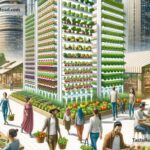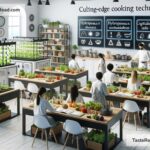The Future of Food and Water Conservation: Building a Sustainable World
Water and food are the basic needs for survival. We use them every day, and without them, life would not exist. But as the world’s population grows, we face serious challenges. Climate change, pollution, and waste are threatening the availability of clean water and enough food for everyone. So, how can we protect these vital resources for future generations? The future of food and water conservation depends on innovation, education, and global teamwork. Let’s take a closer look at how these solutions can create a more sustainable world.
Why Food and Water Conservation Matters
First, let’s understand why this topic is so important. According to the United Nations, by 2050, the world will need 60% more food to feed a growing population. At the same time, water scarcity is already affecting millions of people. Freshwater makes up only 3% of the Earth’s water supply, and two-thirds of that is trapped in glaciers or underground. This means the water we have for drinking, farming, and everyday use is limited.
In addition, farming uses up a lot of water. Agriculture consumes around 70% of the freshwater we use globally. Sadly, much food and water are wasted in this process. For example, nearly one-third of all food produced is thrown away. When food is wasted, the water and energy used to grow and transport it are wasted too.
On top of all this, climate change is making things worse. Droughts, floods, and extreme weather are damaging crops and reducing water supplies. If we don’t act now, these problems will grow—and so will hunger and thirst around the world.
Innovative Solutions for the Future
The good news is that people are coming up with creative ways to solve these issues. Technology is playing a big role in helping us conserve food and water.
1. Smart Farming Techniques
Farmers are using advanced tools to grow food more efficiently. For example, “precision agriculture” uses sensors and drones to track soil and crop health. With this information, farmers can use just the right amount of water and fertilizer, reducing waste and pollution. In addition, vertical farming—where crops are grown in tall buildings—uses less land, less water, and produces food closer to cities, cutting down transportation costs.
Hydroponics is another exciting method. In hydroponic farming, plants grow in water instead of soil. This uses up to 90% less water than traditional farming and can produce fresh food year-round.
2. Better Water Management
Saving water is critical for the future. Some people are using technology to turn dirty water into clean water. For example, water filtration systems and desalination plants make seawater safe for drinking. These tools will be very important in areas where freshwater is hard to find.
Another idea is rainwater harvesting. In many countries, communities are already collecting rainwater to use for farming, cleaning, or drinking. This simple technique can save a lot of water and reduce dependence on rivers and underground reserves.
3. Reducing Food Waste
Cutting down on food waste can also save water. Recycling systems are being developed to turn leftover food into compost or animal feed. Apps now exist to connect surplus food with people who need it, preventing it from ending up in landfills. At home, people can plan meals better and store food properly to reduce waste, helping the planet and their wallet!
Educating People About Conservation
Technology alone is not enough—we also need to educate people about how to live sustainably. Schools and communities can teach children how food is grown and why saving water is important. Simple actions, like turning off the tap while brushing your teeth and eating all the food on your plate, can make a big difference.
Consumers can also support companies that practice sustainability. Many food brands are working to reduce their environmental impact, using eco-friendly packaging and cutting back on water use. By choosing these products, you can support conservation efforts.
Working Together Globally
Food and water conservation isn’t just a local problem—it’s a global issue. Governments, businesses, scientists, and citizens need to work together to come up with solutions. For example:
- International agreements can help protect freshwater sources like rivers and lakes.
- Investments in clean energy can reduce the impact of climate change on agriculture.
- Non-profit organizations can support sustainable farming methods in poorer countries.
By combining efforts, we can create a future where everyone has access to clean water and nutritious food.
Conclusion
The future of food and water conservation holds many challenges, but it also has possibilities. With smart technology, better education, and global teamwork, we can protect these resources for years to come. Small steps, like saving water at home or reducing food waste, can make a big impact if everyone gets involved.
Taking care of food and water isn’t just about us—it’s about our children and grandchildren. It’s about the animals, plants, and ecosystems that depend on these resources to survive. Together, we have the power to build a sustainable world where everyone can thrive. Let’s start today!


